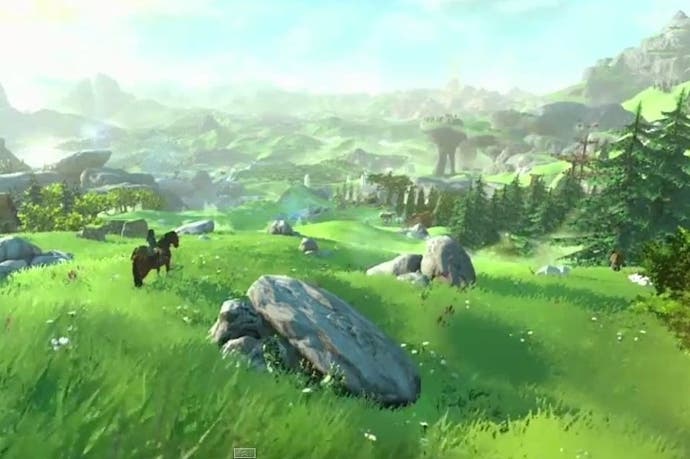"See those mountains?"
E3, scale and game development's favourite cliche.
See those mountains in the distance? You'll be able to climb those. As far as the architecture of a game presentation goes, this phrase is often the keystone. Over the last few years, I've heard it - or variations on it - in reveals for titles as diverse as the Tomb Raider reboot and No Man's Sky. During the first two days of this E3 I clocked it cropping up in briefings for The Witcher and The Legend of Zelda and something else whose name I can no longer read due to my own poor handwriting. Threes on Xbox One, probably.
Seriously, though? Zelda. There's barely been a game announcement for Zelda. We don't know what all that sci-fi technology was doing in the super-quick reveal, and people online were so information-starved that they were initially left pondering whether the Link seen in the video was actually female - or actually Link. Yet what we do know is that there will be mountains in the distance, and that you will be able to climb them, and that this is a good thing.
It probably is a good thing for Zelda. I trust Eiji Aonuma and company to put together a fantasy world that's rich and intricate and built with care and thoughtfulness, so I'm intrigued to see what they'll do with a little more spatial freedom. For most teams, though, it's worth remembering that going open-world only guarantees spatial freedom. It's fine being able to climb those mountains you can see in the distance, but to make that magical still requires a developer who can put something worth finding up there.
And it's especially worth remembering this in the early days of a new hardware generation, when a lot of people are equating bigger worlds and a wider focus with better worlds and more excitement. E3 2014, for all its babbling pleasantness, has been a muddle of contradictions, and this might be the most interesting to me. On one side, there are the games that are continuing the trend of going big, opening out the maps and trusting in sheer scale to do some of the work for them: two-hour cross-country drives in The Crew! The full sweep of revolutionary Paris in Assassin's Creed Unity. On the other side, however, some designers are pursuing a very different tack across a range of genres.
You can see why. One of the unintended consequences of an open world can be a kind of blandness creeping in, especially as open-world systems continue to calcify into rituals. Ubisoft, as is so often pointed out, leads the charge here. Ubisoft's open-world games are increasingly fixated with controlling the map, section by section - screwing around with guard towers and then cleaning up all the nearby quest icons. Are you exploring these spaces, or are you just lawnmowing them?
When a series is as nihilistic and excessive as Far Cry, say, doing all that for the nth time's not really a problem. The structure's just a comforting framework to steady you occasionally as you spin about the landscape getting dizzy from all the explosions. For games like Watch Dogs, though, grey design combines with a grey city to produce an open world that exists under a kind of louring fug. You can hack the game's systems right down to the traffic lights on the lowliest street corner, but you can't fully jolt the place to life. For all its scale, this virtual Chicago struggles to show you something new.
I think there are signs, in the wearying selfie-snapping nuttiness of Far Cry 4's villain, say, or in the distracting hyper-violence and opulent detailing of Assassin's Creed Unity, that the strain is starting to show in even the most dependable open-world games too. The systems that enable exploration might also be quietly choking it, or at the very least turning it into something of a package tour. Maybe scale - the spatial freedom scale provides - can't keep games lively forever. Not by itself, anyway.
So if you suspect open worlds are losing a little of their thrill and that some of the unashamedly expansive games are starting to look ever so slightly ragged, what's the alternative? This E3 had plenty of them, actually. Some were a little unconvincing; I'm still not sure that the intense cinematic scripting that The Order seems to be indulging in will create much of an effect beyond pretty claustrophobia and mustachioed ennui, for example. Some of them, though, were dazzling. In amongst the mega-budget productions with sprawling maps were games - often mega-budget productions in their own right - built around different ideals: games built around focus and empowering limitations. Games built around a studied absence of sprawl.
Take Rainbow Six: Siege, a game that has emerged from a lengthy development hell and now seems put together with a peculiar kind of lavish economy, if that's possible. Rather than rendering a huge world while accepting that the individual buildings are going to blend together somewhat, the tight focus imposed by a competitive tactical shooter allowed the game's demo map to zero in on a single house, filled with convincing domestic clutter - and interior walls and ceilings that could be blasted apart to give such a small floorspace a jolt of genuine dynamism.
In design terms, Siege's suburban stage was essentially a simple corkscrew: take out a few walls and it's just a ramp coiling from the roof down to the front door. The whole thing seems so exciting, though, because you have a map that encourages constant movement while confronting you with tantalising spatial limitations - and viewpoint limitations - that force you to get creative with your destruction. Let's get the drop on these guys by diving in through the ceiling. Let's avoid the barricaded door by busting out the windows. I worry that Siege may be one of those multiplayer games that is only really brilliant if you play it in the right way. Luckily, I suspect the sharpness of the focus might actually help to prod players of all kinds towards that right way of playing.
Elsewhere, From Software's Hidetaka Miyazaki is back with a project that steps away from the Souls games but promises to build proudly on their geographical legacy - and the geographical legacy of the puzzle-box Zeldas, for that matter. In Bloodborne, you've got a city to explore, but it's likely to unfold itself slowly to you. It's a gauntlet rather than a playground, and instead of scaling any mountains in the distance, you'll probably be more interested in sounding the immediate area out for clever shortcuts as you build an understanding of how such a complex, compact space fits together.
There are dozens of other examples, I suspect. For me, though, it's Nintendo that really flew the flag for the focus-over-scale approach this week. Zelda might be going gloriously open-world, but the company's other games positively glittered due to their restrictions. Take Captain Toad: Treasure Tracker, which turns each level into a dense, honeycombed sculpture and robs you of even the simplest abilities like jumping to guarantee that you'll see its video game landscape anew. Take Splatoon, which reimagines the competitive shooter in a manner that's clear-headed, timely and unexpectedly refreshing.
Splatoon is economy itself, in fact, and it shows the riches that can be gained when Nintendo really looks at the wider gaming world and then carefully boils down the key themes it has spotted. You could call it hectic minimalism: beneath the veneer of a rare kind of shooter (one without any military hardware on display), Splatoon's actually a reworked strain of MOBA. It ditches the sometimes-confusing rituals and terminologies of the genre in favour of a paint-balling land-grab mechanic that ties visible progression to your own powers. You paint the environment with ink to win, and you also use the ink you've laid down to gain advantages over your enemies, dipping into it for stealth, speed and even abilities like scaling walls and - I think - reloading ammo. This is focus within focus, mobilis in mobili, right here. Splatoon's banishing sprawl from not just the map but the very mechanics. And, by doing so, it offers the promise of depth and satisfying tactical intricacy alongside a thrilling immediacy.
All of that inside tiny, precision-crafted arenas. Splatoon suggests once more that the size of the map has little to do with the scope of a game or the territory that it explores, in other words. I love the sprawl of a great video game, open-world or otherwise, but sometimes it's nice to ignore the mountains in the distance and focus on the fun that's right in front of you.












